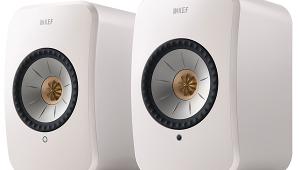Review: Aperion Aris Wireless Windows Speaker

The big box threw me for a second. Some weeks back I'd seen an early prototype of the Aperion Aris, the first Windows 8 Play To certified wireless speaker, and I recalled it being a pretty compact desktop unit. What gives?
Well, it turns out that the manufacturer is so confident in their new product that they sent it to us along with a leading wireless speaker we'd reviewed quite positively, the Bowers & Wilkins Zeppelin Air, along with an A/B switcher and a Sansa Clip full of tunes.
Gauntlet thrown! But we'll get to that in a minute.
Setup: Et tu, Play To?
Sonics aside, the Aris' reason for being is the demand for more and better wireless products that offer seamless connectivity, and in particular Microsoft's entry into that market in a big way with Play To. Blame Apple, or Sonos, or whoever else, but we're seeing more and more attempts at providing one-click wireless audio connectivity (with the introductions coming thick and fast in this iPhone 5- and Android-inspired post-dock era), some rivaling the market leaders, some leaving a bit to be desired. Leave it to Aperion, who've been exploring a variety of wireless options lately, to try out the next (possibly) big thing.
The big news is that Aris is the first wireless speaker that's Play To certified under the much anticipated Windows 8 OS. Play To is a DLNA variant that was rolled out with Windows 7 as part of Windows Media Player, where it's been working - without much fanfare - for the few who've noticed its existence. But with Windows 8, Microsoft is calling attention to the fact that Play To is Microsoft's answer to Apple's AirPlay - it promises that with minimal setup, you can send audio - lossless audio - to any compliant media player living on your wireless network, right from the WMP window.
Just the kind of functionality everybody's clamoring for these days, right?
Rather than throw in every conceivable connection protocol (as Samsung has with their new DA-E750), Aperion's provided the receiver as a separate device, a swappable network card (looks vaguely PCMCIA in format) that plugs into what appears to be a slot on the back of the Aris itself. The device ships with a Windows Play To/DLNA receiver, but the company promises an AirPlay card in Q1 or 2013, with various other interfaces possible down then line (prices aren't yet confirmed, but should range from $49-$99). So after putting the Aris through its paces against the Zeppelin, I plugged in the network card and got to work setting it up to play back from a Windows 7 laptop (sorry, all, we didn't manage to score a Win 8 machine in time for this review).
Configuring the Aris itself was quite simple, and took but a few seconds following the clear quick start card. Log into the speaker via its own Wi-Fi network from whatever device you have handy (I used a Samsung Galaxy SII smartphone), from there sign the device onto your own wireless network, and it's ready to go. Alternately, if you have a WPS router, you can simply press the WPS button on the card to set up. And if for some reason you don't want to go wireless, you can connect via Ethernet. Not being that much of a Luddite, I didn't try that last one.
Now, getting Windows to play nice took a bit more doing. As you might expect, Play To isn't quite as straightforward as AirPlay. (To their credit, Microsoft provides a step-by-step guide to Play To on the Windows site). While any AirPlay device, once set up (and certainly some AirPlay speakers we've tested have made us tear our hair out) is instantly visible to Macs and iDevices on the same network, for PlayTo to function you've got to make a conscious choice to enable streaming; clicking on the Stream menu within WMP, enabling streaming from there, and then setting your streaming preferences by drilling down into another submenu. Easy enough, but these seem to me like the kinds of steps which turn off the average consumer. Your mileage, of course, may vary. Windows 8 should simplify (and beautify) the Play To interface further, but final functionality remains to be seen.
Once I had the Aris on the network, I opened up a Windows 7 laptop (thanks, Bonnier IT folks!), logged into the same Wi-Fi network, loaded up some music files, and launched Windows Media Player. I chose a track, clicked on the Play To button - and found "no devices"! What gives?
I checked the machine's network settings, and sure enough, the Aris was visible. Hmmmmm.
I checked and rechecked my settings, convinced myself all was well, and then decided to make sure the Aris itself was working. I launched Qualcomm's Skifta DLNA server on my phone, chose some music, picked the Aris as my target player, and in a few seconds was playing back - frankly, this made for a far more seamless and slick process than I'd had with the suggested use case so far. This also goes to show that you really don't need a Windows machine to use this thing - any DLNA server will do ya, on smartphone, tablet, or Mac. Add to that the swappable receiver cards, and you don't suffer for choice with this device.
Functionality established, I started poking around various forums. Seems there had been scattered reports that Play To might be wonky (or plain disabled) with unactivated or illegitimate installs of Windows. Sure enough, the copy I had, being a fresh update, hadn't yet been activated. I went ahead and activated, restarted, and lo and behold, when I got WMP up and running again, the Aris was visible under the Play To menu, and playing music was indeed as simple as choosing it as the output device (interestingly, once set up, while you're browsing your hard drive you can right-click on any media file and choose "Play To" to launch the WMP Player window and begin playback to your Play To-compatible device. Kinda neat.
So by comparison with AirPlay, Play To takes a little more doing to get set up, but once the pieces are in place it seems to function as advertised, and takes a bit of the sting out of DLNA, which has developed a reputation (not necessarily deserved, as you can see from my easy-as-pie experience using Skifta as a source with the Aris) for thorny setup. While obviously we couldn't test it with this particular piece of gear, Play To - like AirPlay - also works with video and photos, and it supports a reasonably broad range of networked devices, including a bunch of TVs and networked AVRs.
So I'd suggest to those new to Windows 7 (and also to the piratically inclined among you) - take care that you get right with Microsoft if you want to run an Aris as part of your system. It might not work otherwise.
- Log in or register to post comments






























































